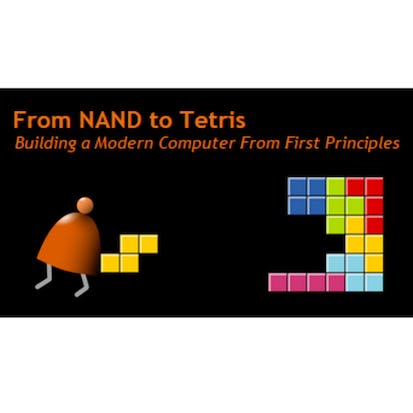- Level Foundation
- المدة 90 ساعات hours
- الطبع بواسطة Hebrew University of Jerusalem
-
Offered by

عن
In this project-centered course you will build a modern software hierarchy, designed to enable the translation and execution of object-based, high-level languages on a bare-bone computer hardware platform. In particular, you will implement a virtual machine and a compiler for a simple, Java-like programming language, and you will develop a basic operating system that closes gaps between the high-level language and the underlying hardware platform. In the process, you will gain a deep, hands-on understanding of numerous topics in applied computer science, e.g. stack processing, parsing, code generation, and classical algorithms and data structures for memory management, vector graphics, input-output handling, and various other topics that lie at the very core of every modern computer system. This is a self-contained course: all the knowledge necessary to succeed in the course and build the various systems will be given as part of the learning experience. The only prerequisite is knowledge of programming at the level acquired in introduction to computer science courses. All the software tools and materials that are necessary to complete the course will be supplied freely after you enrol in the course. This course is accompanied by the textbook "The Elements of Computing Systems" (Nisan and Schocken, MIT Press). While not required for taking the course, the book provides a convenient coverage of all the course topics. The book is available in either hardcopy or ebook form, and MIT Press is offering a 30% discount off the cover price by using the discount code MNTT30 at https://mitpress.mit.edu/books/elements-computing-systems. The course consists of six modules, each comprising a series of video lectures, and a project. You will need about 2-3 hours to watch each module's lectures, and about 15 hours to complete each one of the six projects. The course can be completed in six weeks, but you are welcome to take it at your own pace. You can watch a TED talk about this course by Googling "nand2tetris TED talk". *About Project-Centered Courses: Project-centered courses are designed to help you complete a personally meaningful real-world project, with your instructor and a community of learners with similar goals providing guidance and suggestions along the way. By actively applying new concepts as you learn, you'll master the course content more efficiently; you'll also get a head start on using the skills you gain to make positive changes in your life and career. When you complete the course, you'll have a finished project that you'll be proud to use and share.الوحدات
Course Overview
- Project 0
2
Videos
- Course Overview
- Project 0 Overview
1
Readings
- Week 1 Overview (start here)
Module 0: Machine Language
- Project 4
10
Videos
- Unit 0.0: Machine Language Primer
- Unit 0.1: Machine Language Overview
- Unit 0.2: Machine Language Elements
- Unit 0.3: The Hack Computer and Machine Language
- Unit 0.4: Hack Language Specification
- Unit 0.5: Handling Input and Output
- Unit 0.6: Low-Level Programming, Part I
- Unit 0.7: Low-Level Programming, Part II
- Unit 0.8: Low-Level Programming, Part III
- Unit 0.9: Project 4 Overview
1
Readings
- Module Overview (start here)
Module 1: Virtual Machine I: Stack Arithmetic
- Project 7
11
Videos
- Unit 1.0: The Road Ahead
- Unit 1.1: Program Compilation Preview
- Unit 1.2: VM Abstraction: the Stack
- Unit 1.3: VM Abstraction: Memory Segments
- Unit 1.4: VM Implementation: the Stack
- Unit 1.5: VM Implementation: Memory Segments
- Unit 1.6: The VM Emulator
- Unit 1.7: VM Implementation on the Hack Platform
- Unit 1.8: VM Translator: Proposed Implementation
- Unit 1.9: Project 7: Building the VM Translator, Part I
- Unit 1.10: Perspective
1
Readings
- Module Overview (start here)
Module 2: Virtual Machine II: Program Control
- Project 8
10
Videos
- Unit 2.1: Program Control
- Unit 2.2: Branching
- Unit 2.3: Functions: Abstraction
- Unit 2.4: Function Call and Return: Implementation Preview
- Unit 2.5: Function Call and Return: Run-time Simulation
- Unit 2.6: Function Call and Return Implementation
- Unit 2.7: VM Implementation on the Hack Platform
- Unit 2.8: VM Translator: Proposed Implementation
- Unit 2.9: Project 8: Building the VM Translator, Part II
- Unit 2.10: Perspective
1
Readings
- Module overview (start here)
Module 3: High Level Language
1
Peer Review
- Project 9
11
Videos
- Unit 3.1: The Jack Language in a nutshell
- Unit 3.2: Object-Based Programming
- Unit 3.3: List Processing
- Unit 3.4: Jack Language Specification: Syntax
- Unit 3.5: Jack Language Specification: Data Types
- Unit 3.6: Jack Language Specification: Classes
- Unit 3.7: Jack Language Specification: Methods
- Unit 3.8: Developing Apps using the Jack language and OS
- Unit 3.9: A Sample Jack App: Square Dance
- Unit 3.10: Graphics Optimization
- Unit 3.11: Perspective
1
Readings
- Module Overview (start here)
Module 4: Compiler I: Syntax Analysis
- Project 10
10
Videos
- Unit 4.1: Syntax Analysis
- Unit 4.2: Lexical Analysis
- Unit 4.3: Grammars
- Unit 4.4: Parse Trees
- Unit 4.5: Parser Logic
- Unit 4.6: The Jack Grammar
- Unit 4.7: The Jack Analyzer
- Unit 4.8: The Jack Analyzer: Proposed Implementation
- Unit 4.9: Project 10: Building a Syntax Analyzer
- Unit 4.10: Perspective
1
Readings
- Module Overview (start here)
Module 5: Compiler II: Code Generation
- Project 11
12
Videos
- Unit 5.1: Code Generation
- Unit 5.2: Handling Variables
- Unit 5.3: Handling Expressions
- Unit 5.4: Handling Flow of Control
- Unit 5.5: Handling Objects: Low-Level Aspects
- Unit 5.6: Handling Objects: Construction
- Unit 5.7: Handling Objects: Manipulation
- Unit 5.8: Handling Arrays
- Unit 5.9: Standard Mapping Over the Virtual Machine
- Unit 5.10: Completing the Compiler: Proposed Implementation
- Unit 5.11: Project 11
- Unit 5.12: Perspective
1
Readings
- Module Overview (start here)
Module 6: Operating System
- Project 12
14
Videos
- Unit 6.1: Operating System
- Unit 6.2: Efficiency Matters
- Unit 6.3: Mathematical Operations
- Unit 6.4: Memory Access
- Unit 6.5: Heap Management
- Unit 6.6: Graphics
- Unit 6.7: Line Drawing
- Unit 6.8: Handling Textual Output
- Unit 6.9: Input
- Unit 6.10: String Processing
- Unit 6.11: Array Processing
- Unit 6.12: The Sys Class
- Unit 6.13: Project 12: Building the OS
- Unit 6.14: Perspective
1
Readings
- Module Overview (start here)
Module 7: Postscript: More Fun to Go
4
Videos
- Unit 7.1: More Fun To Go
- Unit 7.2: More Fun To Go
- Unit 7.3: More Fun To Go
- Unit 7.4: More Fun To Go
Auto Summary
Error during summarization:

Instructor
Shimon Schocken


